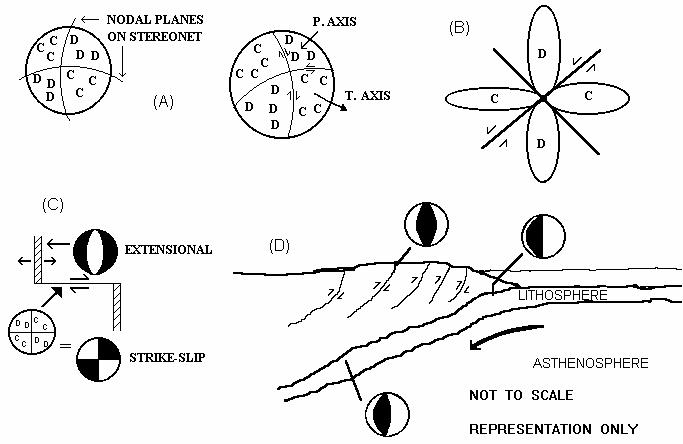After seeing a lot of questions and comments recently about this subject I thought that
a brief explanation may not go amiss. NOTE: I don't claim to be an expert on the subject
and am always open to CONSTRUCTIVE criticism.
The diagram below shows the main types of mechanisms and some of the associated tectonics.
The 'beach balls' show very straight forward mechanisms ie., pure Extension, Compression, and
Strike-slip and although these do occur regularly there is almost infinite number of variations
of these three types. For example the Alpine Fault up the spine of the South Island of New Zealand.
This fault marks the boundary between the Indo-Australian and Pacific plates and is deemed an oblique
thrust fault, ie. it has a strike-slip component and a thrust component.
Fig.1 (A) shows the recorded compressional and dialational first motions as plotted on the lower
hemisphere stereonet. Once a number of first motions have been collected from many seismic recording
stations, a pattern forms that gives a good indication of the focal mech. of the quake. (B) shows
a SW - NE trending left lateral strike-slip fault, indicating the diagonally opposite compression
and dialation quadrants.
FIG.1

(C) here we see a typical rifting situation, eg. the East Pacific Rise or the Mid-Atlantic Ridge
, where sections of spreading ridges (Extensional)are offset by fractures (strike-slip). Finally
in (D) we see a cross-section through a subduction zone. This can be found in many places
around the world, eg the Fiji - Tonga region, Japan, and the Aleutian Is., Alaska. A detailed
study of the focal mechanisms of large subduction zone quakes indicates that they are depth
dependant. Shallow and medium-depth events usually have foc. mech.'s with down-dip extension,
whereas the deeper events > ~300 km have down-dip compression. The former is thought to indicate
that there is a physical barrier slowing or stopping the subducting lithospheric slab. Above
the downgoing slab, the continental crust is undergoing considerable compression resulting in
the numerous high angle reverse (thrust) faults. For Moment Tensor Solutions and maps with the
beachballs for the latest world quakes try this
USGS current seismicity site scroll down the page to the reports for each month and the individual events.

